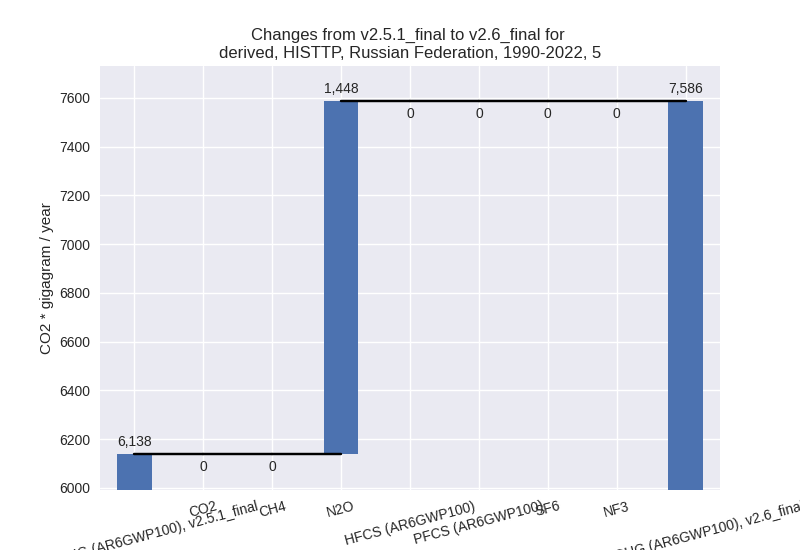Changes in PRIMAP-hist v2.6_final compared to v2.5.1_final for Russian Federation
2024-09-24
Johannes Gütschow
Change analysis for Russian Federation for PRIMAP-hist v2.6_final compared to v2.5.1_final
Overview over emissions by sector and gas
The following figures show the aggregate national total emissions excluding LULUCF AR6GWP100 for the country reported priority scenario. The dotted linesshow the v2.5.1_final data.
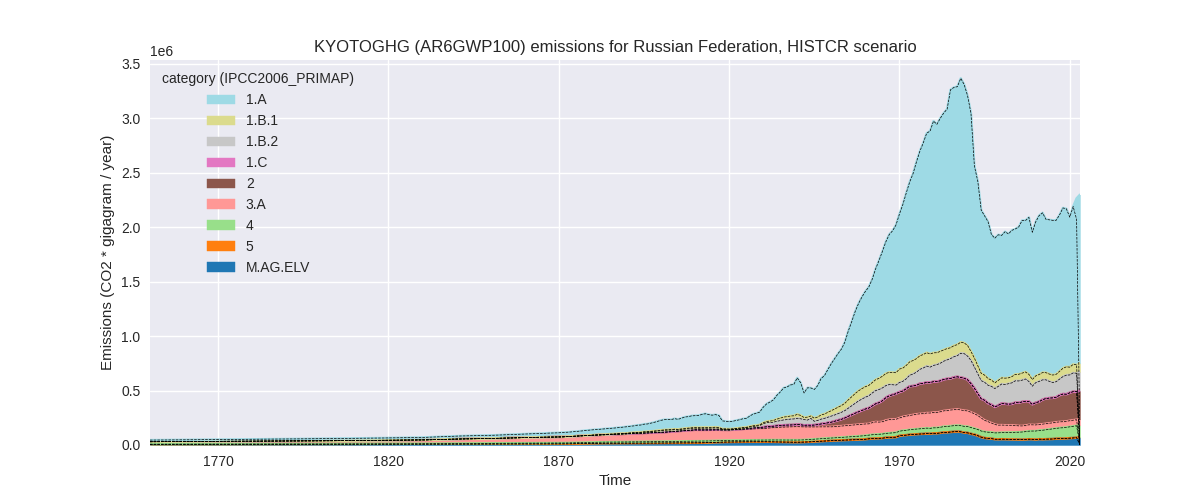
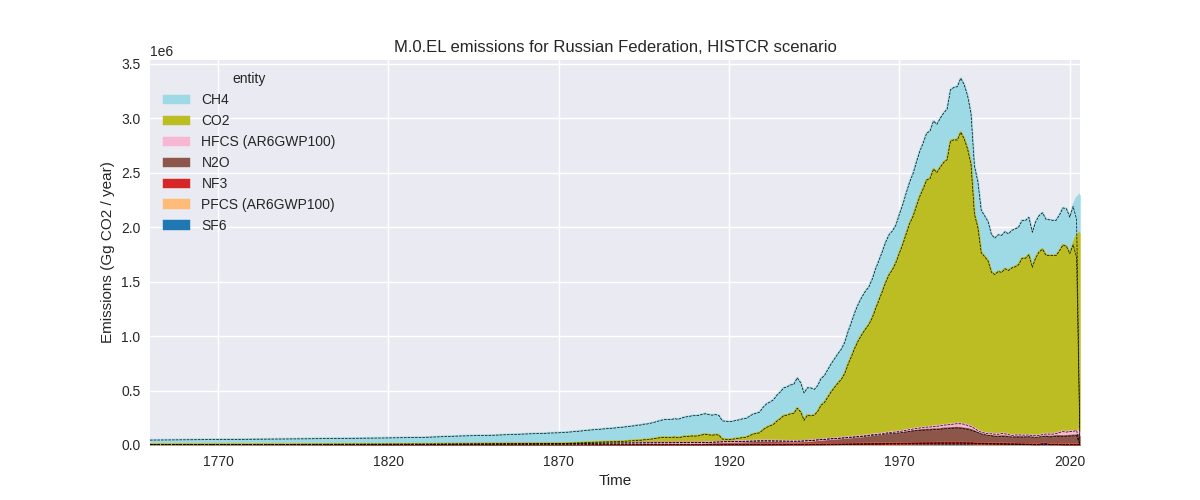
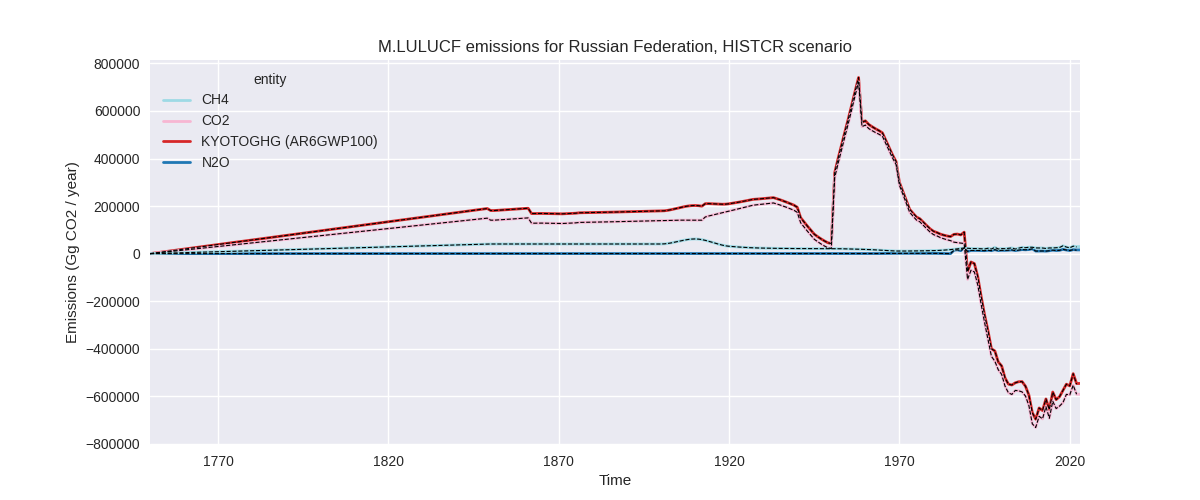
The following figures show the aggregate national total emissions excluding LULUCF AR6GWP100 for the third party priority scenario. The dotted linesshow the v2.5.1_final data.

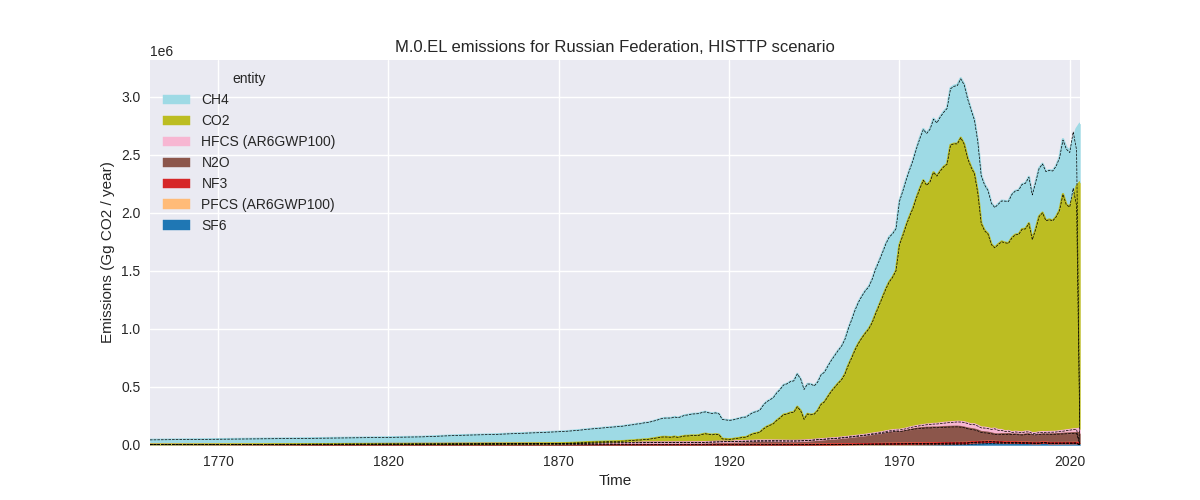

Overview over changes
In the country reported priority scenario we have the following changes for aggregate Kyoto GHG and national total emissions excluding LULUCF (M.0.EL):
- Emissions in 2022 have changed by 9.3%% (192903.90 Gg CO2 / year)
- Emissions in 1990-2022 have changed by 0.3%% (5897.76 Gg CO2 / year)
In the third party priority scenario we have the following changes for aggregate Kyoto GHG and national total emissions excluding LULUCF (M.0.EL):
- Emissions in 2022 have changed by 7.2%% (182790.70 Gg CO2 / year)
- Emissions in 1990-2022 have changed by 0.3%% (6358.89 Gg CO2 / year)
Most important changes per scenario and time frame
In the country reported priority scenario the following sector-gas combinations have the highest absolute impact on national total KyotoGHG (AR6GWP100) emissions in 2022 (top 5):
- 1: 1.A, CO2 with 197833.90 Gg CO2 / year (14.9%)
- 2: 2, HFCS (AR6GWP100) with -5053.15 Gg CO2 / year (-10.6%)
- 3: 2, PFCS (AR6GWP100) with 167.40 Gg CO2 / year (15.9%)
- 4: 1.B.2, CO2 with -65.89 Gg CO2 / year (-0.1%)
- 5: 2, SF6 with -23.40 Gg CO2 / year (-1.9%)
In the country reported priority scenario the following sector-gas combinations have the highest absolute impact on national total KyotoGHG (AR6GWP100) emissions in 1990-2022 (top 5):
- 1: 1.A, CO2 with 5994.97 Gg CO2 / year (0.4%)
- 2: 2, HFCS (AR6GWP100) with -153.13 Gg CO2 / year (-0.6%)
- 3: 2, PFCS (AR6GWP100) with 5.07 Gg CO2 / year (0.1%)
- 4: 1.B.2, CO2 with -2.00 Gg CO2 / year (-0.0%)
- 5: 2, SF6 with -0.71 Gg CO2 / year (-0.0%)
In the third party priority scenario the following sector-gas combinations have the highest absolute impact on national total KyotoGHG (AR6GWP100) emissions in 2022 (top 5):
- 1: 1.A, CO2 with 165206.00 Gg CO2 / year (9.6%)
- 2: 4, CH4 with 15464.69 Gg CO2 / year (13.7%)
- 3: 5, N2O with 1170.92 Gg CO2 / year (23.0%)
- 4: 2, HFCS (AR6GWP100) with 599.23 Gg CO2 / year (1.8%)
- 5: 2, PFCS (AR6GWP100) with -84.34 Gg CO2 / year (-1.6%)
In the third party priority scenario the following sector-gas combinations have the highest absolute impact on national total KyotoGHG (AR6GWP100) emissions in 1990-2022 (top 5):
- 1: 1.A, CO2 with 2395.04 Gg CO2 / year (0.1%)
- 2: 4, CH4 with 2051.03 Gg CO2 / year (2.4%)
- 3: 5, N2O with 1448.47 Gg CO2 / year (23.6%)
- 4: 4, N2O with 28.72 Gg CO2 / year (1.2%)
- 5: 1.B.2, CO2 with 18.87 Gg CO2 / year (0.1%)
Notes on data changes
Here we list notes explaining important emissions changes for the country. ’' means that the following text only applies to the TP time series, while means that it only applies to the CR scenario. Otherwise the note applies to both scenarios.
- We have no new country reported data for Russia.
- Higher energy CO2 emissions come from new EI2024 data which shown an increase from 2021 to 2022 while EI2023 shows a decrease (CR, TP).
- Changes in HFCs and PFCs because of the shorter trend period for numerical extrapolation (mainly CR).
- Changes in sectors 4 and 5 in the TP scenario are due to the removal of FAOSTAT data.
Changes by sector and gas
For each scenario and time frame the changes are displayed for all individual sectors and all individual gases. In the sector plot we use aggregate Kyoto GHGs in AR6GWP100. In the gas plot we usenational total emissions without LULUCF. ## country reported scenario
2022
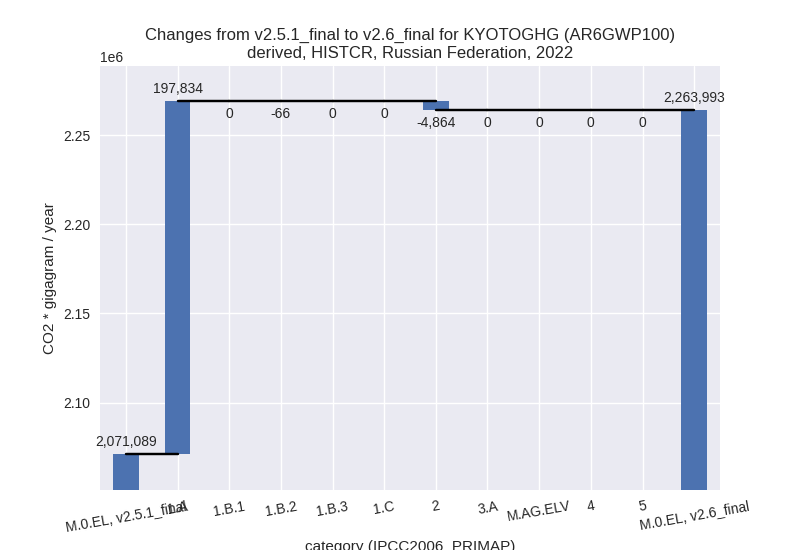

1990-2022
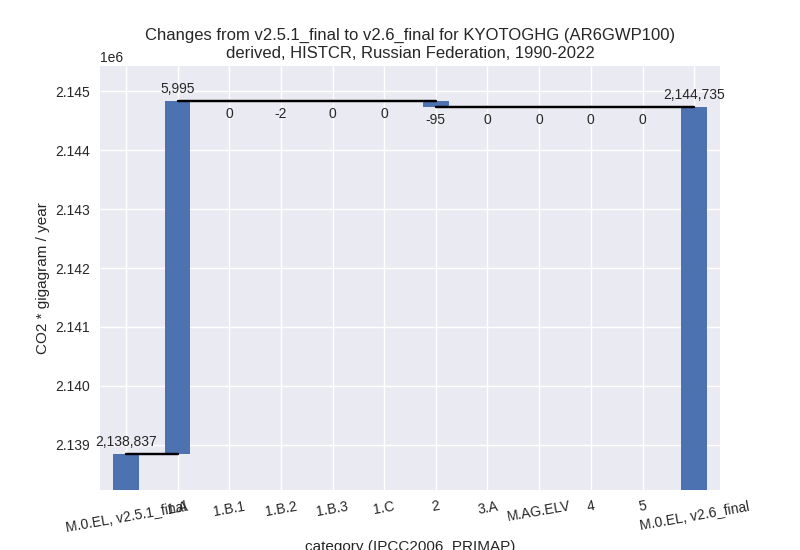
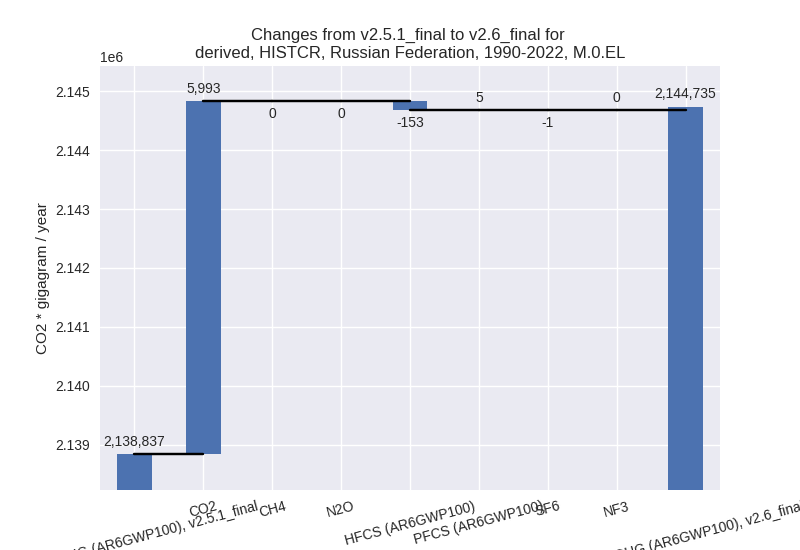
third party scenario
2022
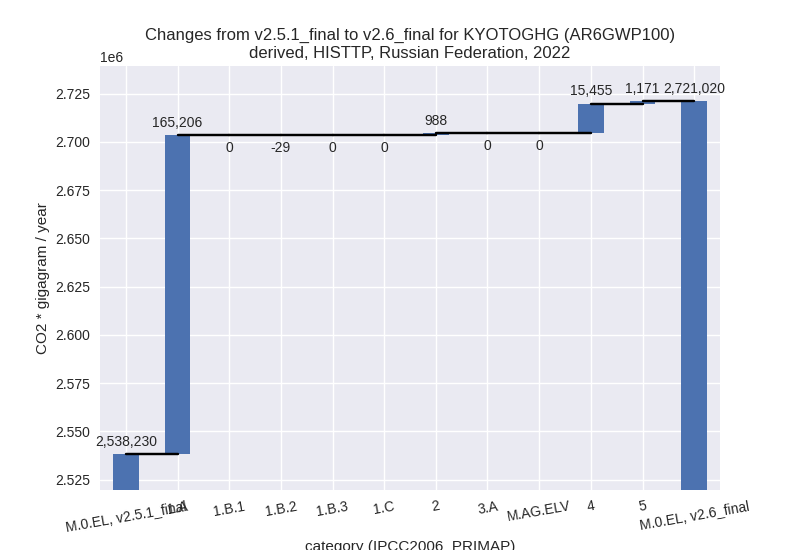
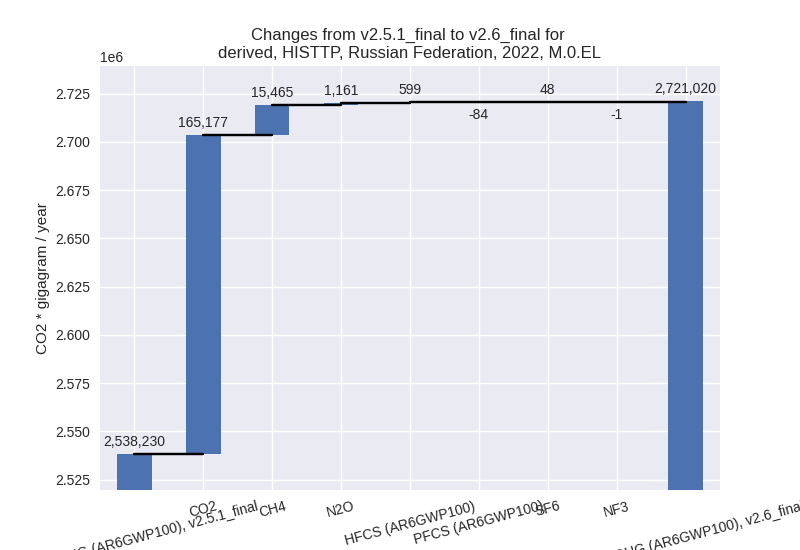
1990-2022
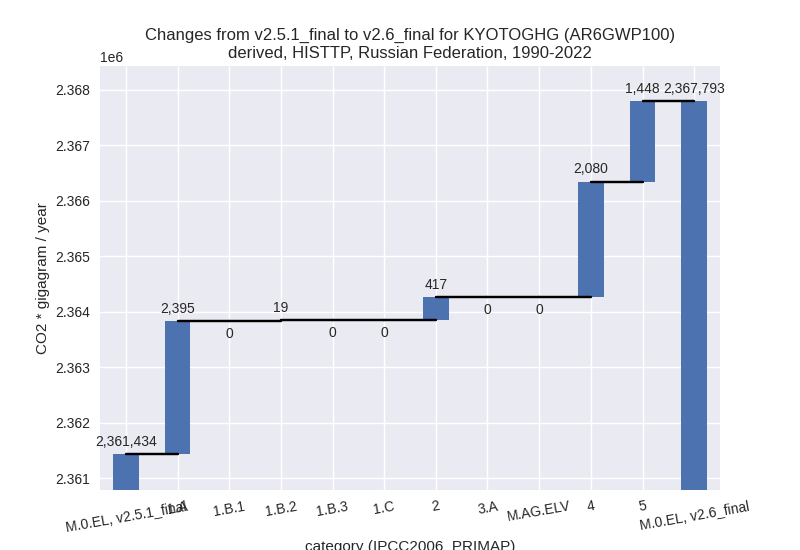
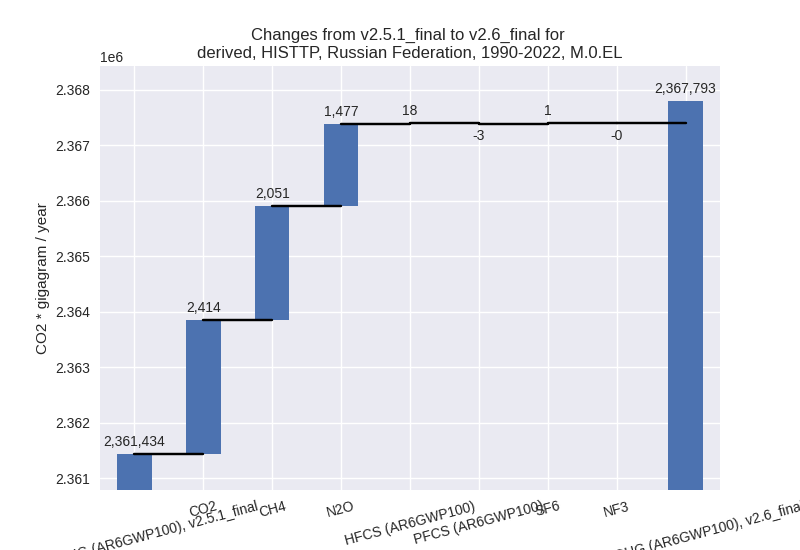
Detailed changes for the scenarios:
country reported scenario (HISTCR):
Most important changes per time frame
For 2022 the following sector-gas combinations have the highest absolute impact on national total KyotoGHG (AR6GWP100) emissions in 2022 (top 5):
- 1: 1.A, CO2 with 197833.90 Gg CO2 / year (14.9%)
- 2: 2, HFCS (AR6GWP100) with -5053.15 Gg CO2 / year (-10.6%)
- 3: 2, PFCS (AR6GWP100) with 167.40 Gg CO2 / year (15.9%)
- 4: 1.B.2, CO2 with -65.89 Gg CO2 / year (-0.1%)
- 5: 2, SF6 with -23.40 Gg CO2 / year (-1.9%)
For 1990-2022 the following sector-gas combinations have the highest absolute impact on national total KyotoGHG (AR6GWP100) emissions in 1990-2022 (top 5):
- 1: 1.A, CO2 with 5994.97 Gg CO2 / year (0.4%)
- 2: 2, HFCS (AR6GWP100) with -153.13 Gg CO2 / year (-0.6%)
- 3: 2, PFCS (AR6GWP100) with 5.07 Gg CO2 / year (0.1%)
- 4: 1.B.2, CO2 with -2.00 Gg CO2 / year (-0.0%)
- 5: 2, SF6 with -0.71 Gg CO2 / year (-0.0%)
Changes in the main sectors for aggregate KyotoGHG (AR6GWP100) are
- 1: Total sectoral emissions in 2022 are 1777050.10
Gg CO2 / year which is 78.5% of M.0.EL emissions. 2022 Emissions have
changed by 12.5% (197768.00 Gg CO2 /
year). 1990-2022 Emissions have changed by 0.4% (5992.97 Gg CO2 / year). For 2022 the
changes per gas
are:

The changes come from the following subsectors:- 1.A: Total sectoral emissions in 2022 are
1531224.80 Gg CO2 / year which is 86.2% of category 1 emissions. 2022
Emissions have changed by 14.8%
(197834.00 Gg CO2 / year). 1990-2022 Emissions have changed by 0.4% (5994.97 Gg CO2 / year). For 2022 the
changes per gas
are:
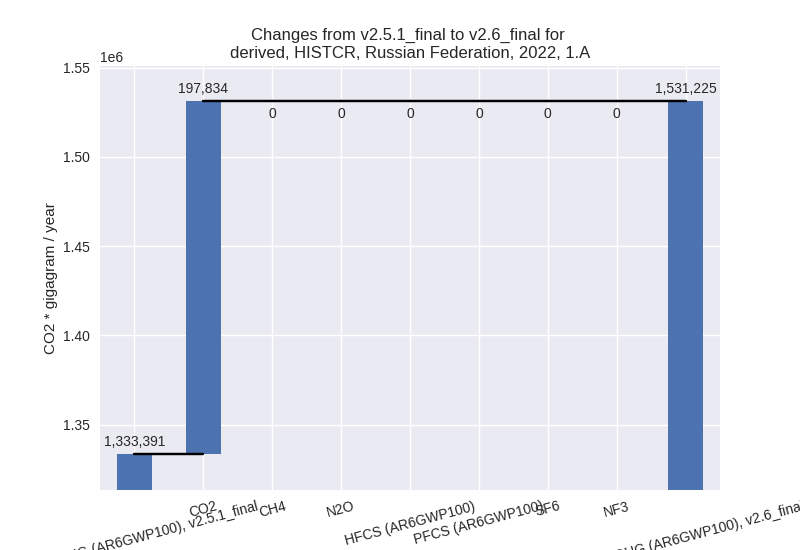
There is no subsector information available in PRIMAP-hist. - 1.B.1: Total sectoral emissions in 2022 are 79059.64 Gg CO2 / year which is 4.4% of category 1 emissions. 2022 Emissions have changed by 0.0% (0.00 Gg CO2 / year). 1990-2022 Emissions have changed by 0.0% (0.00 Gg CO2 / year).
- 1.B.2: Total sectoral emissions in 2022 are 166765.69 Gg CO2 / year which is 9.4% of category 1 emissions. 2022 Emissions have changed by -0.0% (-65.89 Gg CO2 / year). 1990-2022 Emissions have changed by -0.0% (-2.00 Gg CO2 / year).
- 1.A: Total sectoral emissions in 2022 are
1531224.80 Gg CO2 / year which is 86.2% of category 1 emissions. 2022
Emissions have changed by 14.8%
(197834.00 Gg CO2 / year). 1990-2022 Emissions have changed by 0.4% (5994.97 Gg CO2 / year). For 2022 the
changes per gas
are:
- 2: Total sectoral emissions in 2022 are 255188.98 Gg CO2 / year which is 11.3% of M.0.EL emissions. 2022 Emissions have changed by -1.9% (-4864.22 Gg CO2 / year). 1990-2022 Emissions have changed by -0.0% (-95.19 Gg CO2 / year).
- M.AG: Total sectoral emissions in 2022 are 123188.97 Gg CO2 / year which is 5.4% of M.0.EL emissions. 2022 Emissions have changed by 0.0% (0.00 Gg CO2 / year). 1990-2022 Emissions have changed by 0.0% (0.00 Gg CO2 / year).
- 4: Total sectoral emissions in 2022 are 108564.61 Gg CO2 / year which is 4.8% of M.0.EL emissions. 2022 Emissions have changed by 0.0% (0.00 Gg CO2 / year). 1990-2022 Emissions have changed by 0.0% (0.00 Gg CO2 / year).
- 5: No data
third party scenario (HISTTP):
Most important changes per time frame
For 2022 the following sector-gas combinations have the highest absolute impact on national total KyotoGHG (AR6GWP100) emissions in 2022 (top 5):
- 1: 1.A, CO2 with 165206.00 Gg CO2 / year (9.6%)
- 2: 4, CH4 with 15464.69 Gg CO2 / year (13.7%)
- 3: 5, N2O with 1170.92 Gg CO2 / year (23.0%)
- 4: 2, HFCS (AR6GWP100) with 599.23 Gg CO2 / year (1.8%)
- 5: 2, PFCS (AR6GWP100) with -84.34 Gg CO2 / year (-1.6%)
For 1990-2022 the following sector-gas combinations have the highest absolute impact on national total KyotoGHG (AR6GWP100) emissions in 1990-2022 (top 5):
- 1: 1.A, CO2 with 2395.04 Gg CO2 / year (0.1%)
- 2: 4, CH4 with 2051.03 Gg CO2 / year (2.4%)
- 3: 5, N2O with 1448.47 Gg CO2 / year (23.6%)
- 4: 4, N2O with 28.72 Gg CO2 / year (1.2%)
- 5: 1.B.2, CO2 with 18.87 Gg CO2 / year (0.1%)
Changes in the main sectors for aggregate KyotoGHG (AR6GWP100) are
- 1: Total sectoral emissions in 2022 are 2301814.50
Gg CO2 / year which is 84.6% of M.0.EL emissions. 2022 Emissions have
changed by 7.7% (165176.60 Gg CO2 /
year). 1990-2022 Emissions have changed by 0.1% (2413.89 Gg CO2 / year). For 2022 the
changes per gas
are:
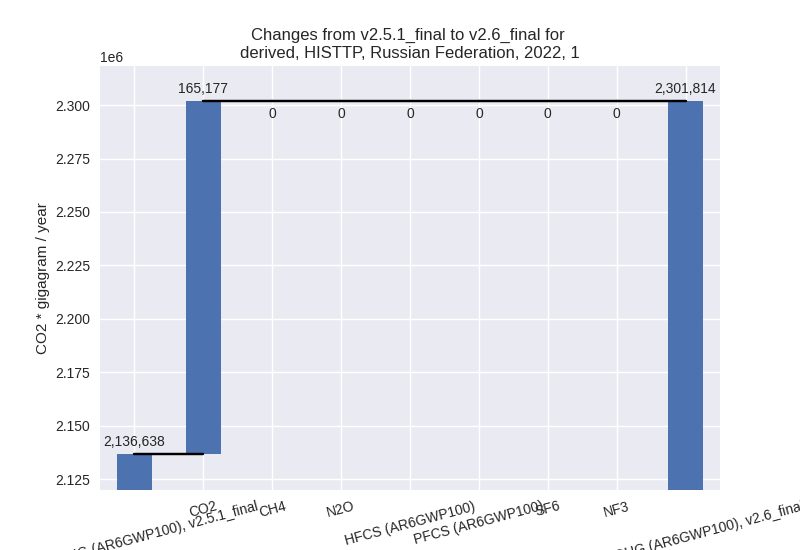
The changes come from the following subsectors:- 1.A: Total sectoral emissions in 2022 are
1895172.00 Gg CO2 / year which is 82.3% of category 1 emissions. 2022
Emissions have changed by 9.5%
(165205.90 Gg CO2 / year). 1990-2022 Emissions have changed by 0.1% (2395.03 Gg CO2 / year). For 2022 the
changes per gas
are:
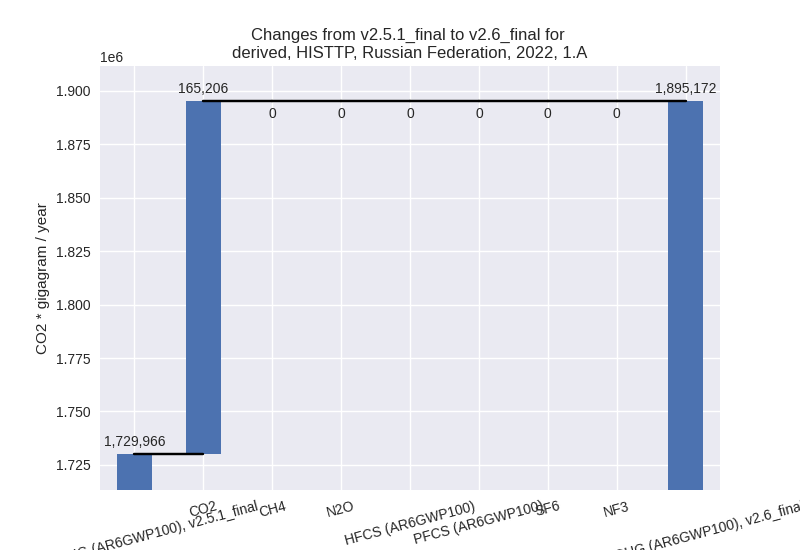
There is no subsector information available in PRIMAP-hist. - 1.B.1: Total sectoral emissions in 2022 are 152950.75 Gg CO2 / year which is 6.6% of category 1 emissions. 2022 Emissions have changed by 0.0% (0.00 Gg CO2 / year). 1990-2022 Emissions have changed by 0.0% (0.00 Gg CO2 / year).
- 1.B.2: Total sectoral emissions in 2022 are 253691.74 Gg CO2 / year which is 11.0% of category 1 emissions. 2022 Emissions have changed by -0.0% (-29.35 Gg CO2 / year). 1990-2022 Emissions have changed by 0.0% (18.87 Gg CO2 / year).
- 1.A: Total sectoral emissions in 2022 are
1895172.00 Gg CO2 / year which is 82.3% of category 1 emissions. 2022
Emissions have changed by 9.5%
(165205.90 Gg CO2 / year). 1990-2022 Emissions have changed by 0.1% (2395.03 Gg CO2 / year). For 2022 the
changes per gas
are:
- 2: Total sectoral emissions in 2022 are 169199.52 Gg CO2 / year which is 6.2% of M.0.EL emissions. 2022 Emissions have changed by 0.6% (988.38 Gg CO2 / year). 1990-2022 Emissions have changed by 0.3% (416.78 Gg CO2 / year).
- M.AG: Total sectoral emissions in 2022 are 112595.45 Gg CO2 / year which is 4.1% of M.0.EL emissions. 2022 Emissions have changed by 0.0% (0.00 Gg CO2 / year). 1990-2022 Emissions have changed by 0.0% (0.00 Gg CO2 / year).
- 4: Total sectoral emissions in 2022 are 131151.34
Gg CO2 / year which is 4.8% of M.0.EL emissions. 2022 Emissions have
changed by 13.4% (15454.83 Gg CO2 /
year). 1990-2022 Emissions have changed by 2.4% (2079.74 Gg CO2 / year). For 2022 the
changes per gas
are:
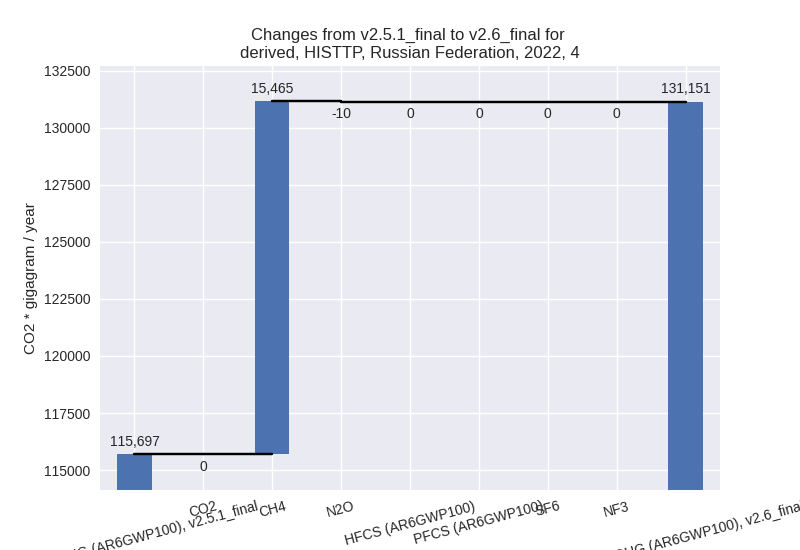
For 1990-2022 the changes per gas are: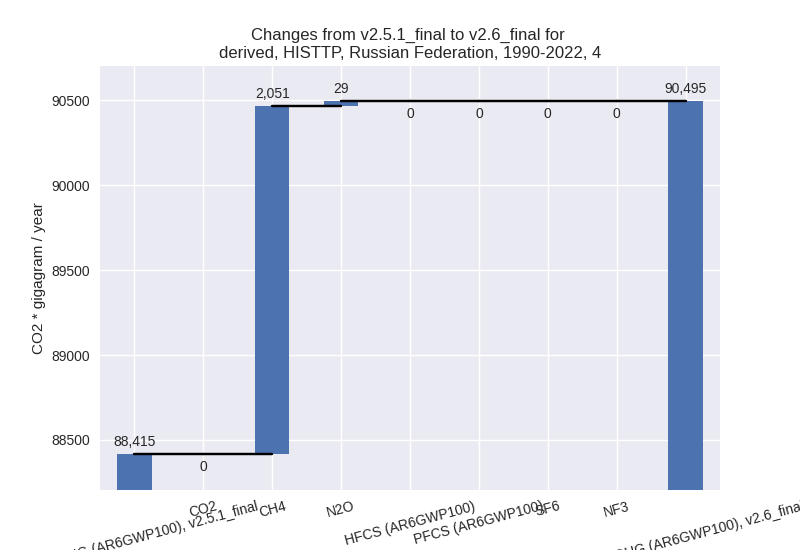
- 5: Total sectoral emissions in 2022 are 6259.61 Gg
CO2 / year which is 0.2% of M.0.EL emissions. 2022 Emissions have
changed by 23.0% (1170.92 Gg CO2 /
year). 1990-2022 Emissions have changed by 23.6% (1448.47 Gg CO2 / year). For 2022
the changes per gas
are:
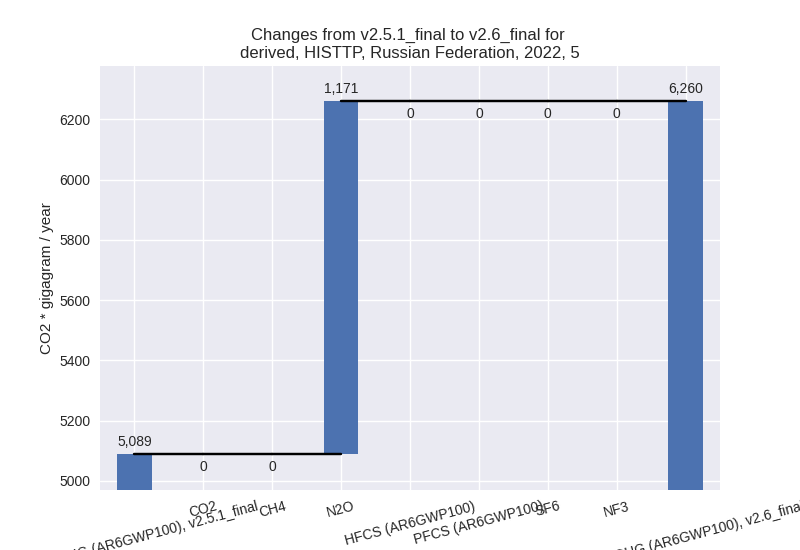
For 1990-2022 the changes per gas are: